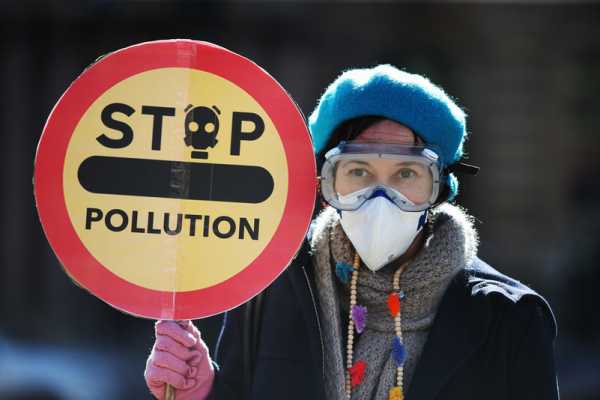
Pollution is the cause of over 10 percent of all cancer cases in Europe — while the percentage may seem small, the impact is enormous for European citizens, accounting for at least 270,000 cases per year (Photo: Friends of the Earth Scotland)
While Europe has made great gains in reducing pollution over past decades, we know all too well that we still live with too much pollution and environmental risks in our lives.
Exposure to air pollution, certain chemicals and ultraviolet radiation and other hazards in our environment and at the workplace is the cause of over 10 percent of all cancer cases in Europe, according to our latest European Environment Agency study.
While the percentage may seem small, the impact is enormous for European citizens, accounting for at least 270,000 cases per year.
The good news is that most of this environmental burden of disease can be avoided when we take action to improve the quality of the environment around us, drastically reduce pollution as stated in the EU’s Zero Pollution Action Plan and change our behaviour.
Some determinants of cancer like age and intrinsic factors cannot be modified, but most if not all environmental and occupational exposures can be prevented or seriously mitigated. Reducing exposure offers an effective way of reducing cancer cases and associated deaths.
And although citizens can make choices to reduce their exposure to environmental health risks, it is obvious that government regulation, like reducing air pollution in city centres through cleaner transport, by banning the most harmful chemicals in products and enforcing occupational health and safety standards is vital. Better implementation of the EU’s tools and policies would also go a long way to addressing this huge challenge.
The European Green Deal is crucial in pushing this environmental health agenda further through its focus on Zero Pollution, the Chemicals Strategy which has the “Safe and Sustainable” principle at the core, and multiple other policies that address pollution, environmental quality and health issues.
This also includes the Farm to Fork strategy, which aims at reducing exposure to carcinogens by addressing the use of chemicals in the food system. These regulatory steps are pushing economic players towards innovation and sustainability in a much more essential and systemic way than previous legislation.
And there is good reason to do this.
With nearly three million new patients and 1.3 million deaths each year across the EU, cancer takes a tremendous toll on our society and its very likely that cancer has directly impacted your life or that of someone you love or know. The economic costs are also enormous, estimated at around €17bn in 2018 alone.
Scientific research shows that air pollution is linked to 17 percent of deaths from lung cancer in Europe and causes overall around two percent of all cancer deaths.
Recent studies have detected associations between long term exposure to particulate matter, a key air pollutant, and leukemia in adults and children. Radon and ultraviolet radiation contribute significantly to cancer cases as does exposure to second-hand smoke.
Chemicals like lead, arsenic, pesticides and polyfluorinated alkyl substances (PFAS) and many others are also suspected to induce cancer in multiple organs. The impact of chemicals in the environment and at the workplace on cancers is probably much higher than what we know today. While banned years ago, asbestos — a well-known carcinogen — continues to account for 55 to 88 percent of occupational lung cancers.
We know that reducing these cancer cases won’t happen overnight, it’s a complex battle.
What is achievable?
It will take long-term commitment from all levels of European government and a serious transformation in our industries, but it’s one that if we put our minds to it, we can achieve it. For example, cleaner air helped save hundreds of thousands of lives in Europe.
The implementation of EU, national and local policies and measures across Europe has led to reduction in emissions of all air pollutants, which in turn has led to a reduction of the population’s exposure to health impacts.
Overall emissions of all key air pollutants across the EU declined in 2021, maintaining the trend seen since 2005. Still, delivering clean and safe air for Europe will require additional reductions in emissions by national and local authorities and linking clean air with economic recovery.
The EU’s Zero Pollution Action Plan targets further reductions in air and water pollution aiming to reduce human exposure as does the EU’s Chemicals Strategy for Sustainability which aims to ban the most harmful chemicals in products, including those that cause cancer, while making chemicals safe and sustainable by design.
The proposed Restoration Law also aims to reduce the use and risk of chemical pesticides by 50 percent by 2030. This builds on the existing landmark EU legislation in this area.
Other EU actions include legally binding requirements on the protection from exposure to natural radiation sources, protecting workers’ health and safety, assessing and restricting chemical carcinogens and coordinating European efforts to tackle second-hand smoking and raising awareness of the dangers linked to sunbathing.
Many cancer cases can be prevented if we take stronger action to reduce pollution and make sure governments as well as industry live up to their commitments to implement existing EU rules and regulations to cut pollution.
Every action and investment we make to reduce pollution will improve the health of all of us and the health of our environment. Delayed action is very likely to result in higher social and health costs. In the end, prevention is the best treatment.
Source: euobserver.com



